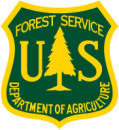This project will remove and replace four concrete low water fords on tributaries of the Glover and Mountain Fork rivers on the boundary of Ouachita National Forest in Oklahoma. A low water ford is a shallow area in a river or stream that allows vehicles to pass when water is low. Replacing these with new structures will increase the ability of aquatic organisms to migrate through the rivers and provide safer, more sustainable infrastructure for vehicles. Improved stream connectivity and habitat accessibility will benefit the Ouachita shiner and threatened leopard darter. These crossings are a high priority as this is the only watershed where leopard darter exists. This project will provide meaningful benefits to the surrounding community by improving the safety of the crossings and providing improved access to camping, fishing, and other recreational activities within the national forest.
Project Quick Facts:
Project Status | In Development |
Location | OK, McCurtain County |
NFPP Project Funding | $1,000,000 |
Restoration Techniques | Low water ford replacement |
Accomplishments | 14 Stream Miles Reopened |
Partner Project Lead | Ouachita National Forest |
The National Fish Passage Program: Leaders in Building Bridges and Fostering Connections
The National Fish Passage Program is a national leader connecting watersheds and people. The program has decades of experience implementing infrastructure projects with partners. Fish passage project proposals can be initiated by any individual, organization, government, or agency. However, proposals must be submitted and completed in cooperation with a Fish and Wildlife Conservation Office. (Please note that fish passage fish passage
Fish passage is the ability of fish or other aquatic species to move freely throughout their life to find food, reproduce, and complete their natural migration cycles. Millions of barriers to fish passage across the country are fragmenting habitat and leading to species declines. The U.S. Fish and Wildlife Service's National Fish Passage Program is working to reconnect watersheds to benefit both wildlife and people.
Learn more about fish passage projects being used for federal or state compensatory mitigation or required by existing federal or state regulatory programs are not eligible for funding through the National Fish Passage Program.)
CONTACT A FISH PASSAGE COORDINATOR IN YOUR AREA TO GET STARTED.
200 Million Dollar Investment in Rivers, Wildlife, and Communities
Clean free-flowing waterways are vital to wildlife, people, and ecosystems. But across the country, millions of barriers fragment rivers, block fish migration, and put communities at higher risk to flooding. The Bipartisan Infrastructure Law Bipartisan Infrastructure Law
The Bipartisan Infrastructure Law (BIL) is a once-in-a-generation investment in the nation’s infrastructure and economic competitiveness. We were directly appropriated $455 million over five years in BIL funds for programs related to the President’s America the Beautiful initiative.
Learn more about Bipartisan Infrastructure Law , signed in November 2021, included $200 million for restoring fish and wildlife passage by removing in-stream barriers and providing technical assistance under the National Fish Passage Program.


